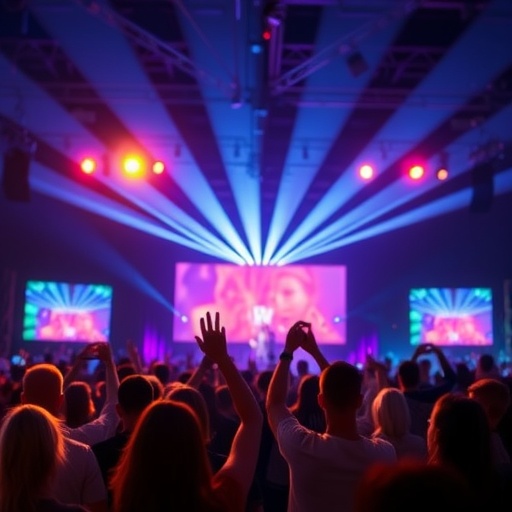A groundbreaking study emerging from collaborative efforts between the University of Georgia and Brigham Young University sheds new light on how live events serve as powerful catalysts in mitigating feelings of loneliness and enhancing social connectedness. Set to appear in the upcoming issue of Social Psychological and Personality Science, this research meticulously dissects the specific event features that most effectively generate a tangible sense of belonging among participants.
The research, spearheaded by Drs. Richard Slatcher of UGA and Julianne Holt-Lunstad of BYU, hinges on data drawn from a robust sample of 1,551 individuals. These participants documented their subjective experiences immediately before and after attending various communal events, including but not limited to concerts, fitness sessions, and community gatherings. This extensive data collection provided a nuanced understanding of the social mechanisms at play during live interactions.
Central to the researchers’ conclusions is the identification of active participation as the paramount predictor of social connection. Far beyond mere physical presence in a crowd, engagement that encourages interaction and personal involvement appears to ignite more profound feelings of affiliation. Dr. Slatcher emphasizes that active involvement—such as participating in discussions, collaborative activities, or interactive performances—surpasses passive observation in fostering a genuine sense of connection.
Furthermore, the study underscores the importance of attending events in person rather than virtually. While digital gatherings have surged in popularity, especially in the wake of the COVID-19 pandemic, the tactile and embodied elements inherent in live events significantly amplify social bonding. The physical proximity and shared environment create multisensory experiences that digital platforms cannot fully replicate, reinforcing the fabric of social ties.
Another compelling finding is the role of reciprocal attendance alongside others. Attending events in the company of friends, family, or even acquaintances consistently enhances feelings of togetherness. This social accompaniment not only provides emotional security but also amplifies opportunities for interaction, dialogue, and mutual engagement. Importantly, recurring attendance further entrenches these social bonds, suggesting that consistency over time is key to building enduring networks.
From an applied perspective, the research holds profound implications for event organizers across multiple domains, including community coordinators, corporate planners, and cultural curators. Dr. Holt-Lunstad calls upon event designers to minimize passive consumption elements. Instead, events should be structured to prioritize active engagement, incorporating hands-on activities, interactive discussions, and opportunities for attendees to assume responsibility or leadership roles, thereby weaving social interaction into the very fabric of the event.
The study’s timing is particularly salient as societies worldwide grapple with the lingering aftermath of pandemic-induced isolation. Dr. Slatcher highlights the urgent relevance of these findings, given the widespread struggles with loneliness, now officially declared an epidemic by the U.S. Surgeon General. The research not only provides empirical backing to public health initiatives aiming to rekindle community ties but also offers practical, evidence-based strategies to counteract the social void left by prolonged physical distancing.
Yet, the study also reveals an inherent limitation: the intensification of social connection tends to be ephemeral. Although feelings of togetherness peak during and immediately after events, this heightened social state generally diminishes within 24 hours. This temporal aspect points to the crucial need for regular, sustained social engagement to preserve and deepen these connections over the long term.
Dr. Slatcher advocates for embedding live events within an ongoing routine, such as weekly classes, recurring cultural activities, or habitual social meetups. This approach not only reinforces a sense of belonging but may serve as a preventive measure against the chronic social isolation that increasingly characterizes modern societies. The findings urge individuals and communities alike to prioritize consistent participation in meaningful social contexts.
The research team also critiques the qualitative variability across events, emphasizing that not all gatherings are equally conducive to fostering social connection. The contextual factors, such as the event’s structure, facilitation style, and participant dynamics, decisively shape the outcome. This nuance signals a need for further empirical exploration into how varying event formats and content can differentially impact social bonding.
Looking ahead, the authors plan to delve into mechanisms that enable momentary feelings of connection to transform into lasting social fabric. Dr. Slatcher remarks that while social psychology has advanced in identifying what triggers human connection, a significant frontier remains: uncovering how to maintain and deepen these ties beyond ephemeral moments.
In a progressive move towards knowledge translation, the researchers have developed an accessible toolkit titled “Events 4 Connection.” This resource distills their findings into actionable strategies, empowering individuals, organizations, and communities to design and participate in live events that genuinely nurture social cohesion. Made publicly available online, the toolkit serves as a pragmatic extension of the study, bridging theory with real-world application.
This study not only reinforces the fundamental nature of humans as social beings but also provides a strategic roadmap for reversing the growing tide of social isolation. By emphasizing in-person, participatory, and recurring engagement, it reframes live events as crucial social infrastructure with the power to rebuild community resilience. Amidst an increasingly digitized and fragmented world, these insights are invaluable for charting a path toward collective well-being and connection.
Subject of Research: People
Article Title: Actively Participating in Live Events as an Avenue for Social Connection
News Publication Date: 25-Aug-2025
Web References:
References:
DOI: 10.1177/19485506251360041
Keywords: social connection, loneliness, live events, active participation, in-person engagement, recurring attendance, social isolation, community building




